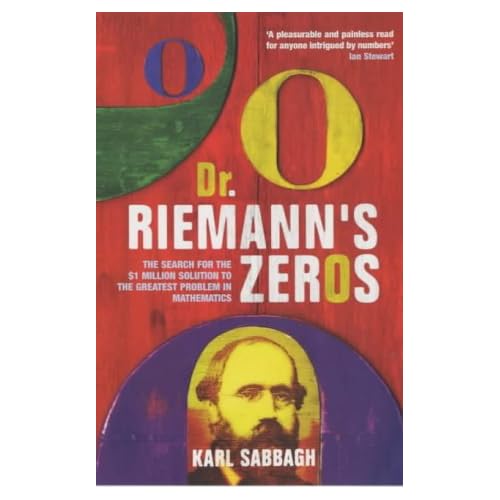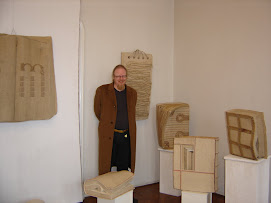 Math has probably never been cooler than it is right now. This is caused by the usual cocktail of money and image/exposure. Two geeky manifestations support my claim...
Math has probably never been cooler than it is right now. This is caused by the usual cocktail of money and image/exposure. Two geeky manifestations support my claim...
Lately, more popular science books on maths related themes than ever before have begun to appear. I know because my wife likes to read this type of thing, so I pick them up at airports and similar places. Barry Mazur's Imagining Numbers (Particularly the Square Root of Minus Fifteen), John D. Barrow's The Book of Nothing, Robert Kaplan's The Nothing That Is: A Natural History of Zero, Brian Clegg's Infinity: The Quest to Think the Unthinkable to name but a few.... Amazon literally provides dozens of similar titles.
Now even more focused and specialized phenomena have become the topic of 'biographies' in this vein. Where Zero and Infinity seemed the dynamic duo, the Robin and Batman of the previous generation of popular math books, the new protagonist superheroes are the Prime numbers. Partly, this is due to the publicity afforded quite esoteric matters such as the Riemann Hypothesis and other conundrums in math since the Clay Mathematics Institute offered a million dollars for the solution of each of seven big problems in math that had so far resisted proof, including the Riemann.
So far, the most publicity has gone to a rather obscure and eccentric Russian mathematician, Grigory Perelman, who seems to have dealt with the so-called Poincaré Conjecture, although it may turn out that adjudicating whether proposed solutions are truly valid or not may not be a trivial thing. Certainly I cannot quite figure out if Perelman has been given his million yet - or even wants it (he did get the so-called Fields Medal for his work but declined the award )... The BBC has a somewhat poppy video on this.
Back to the Riemann issue. This problem has to do with the frequency and distribution of prime numbers in the list of integers or whole numbers. It seems indisputable that there are proportionally more primes among the lower numbers in this infinite list, but what one cannot really prove is that despite the fact that there are fewer primes among higher numbers there will never be a point on the list where the last, highest prime is located. One assumes that there will never be a final prime - but can this be mathematically proven? This is not in itself a particularly sexy problem, and it doesn't even seem to be a problem whose solution will automatically generate a lot of practical advantages in the form of patents, products or other money-making propositions...
Despite this, the Riemann hypothesis has generated at least 5 popular books after the announcement of the Millennium problems: John Derbyman's Prime Obsession: Bernhard Riemann and the Greatest Unsolved Problem in Mathematics; Marcus Du Sautoy's The Music of the Primes: Seeking to Solve the Greatest Mystery in Mathematics; Dan Rockmore's Stalking the Riemann Hypothesis: The Quest to Find the Hidden Law of Prime Numbers; Keith J. Devlin's The Millennium Problems: The Seven Greatest Unsolved Mathematical Puzzles of Our Time; and Karl Sabbagh's Dr. Riemann's Zeros (apparently also published as The Riemann Hypothesis: The Greatest Unsolved Problem in Mathematics)... One notes that most of these titles try to sex up the subject by borrowing terminology from best-selling genres: Detective novel: "Unsolved mystery!" True crime: "Stalking!" and Romance: "Quest to Find!"
I only have one of these books, Sabbagh's volume, and my comments therefore only really specifically address his book. His prologue is illuminating: It starts with a comparison between popular anthropology books and books about mathematicians, the premise being that math geeks are also an exotic tribe whose behaviour can be very exciting to follow from a safe distance comfortably seated in your armchair. The Trobrianders, the Nuer and the Geeks, same thing: foreign languages, bizarre rituals and social customs, uncharted sex lives... This is of course familiar territory from other popular representations of math geeks: John Nash, the schizophrenic real-life protagonist of Oscar-winning film A Beautiful Mind (and the less-known Gwynneth Paltrow-vehicle Proof, which follows his daughter's problems with her father's legacy), is the most prominent case in point.
Sabbagh then moves on to anecdotes about how kids choose the math-path at a very early age and through all their stories talk about their considerable persistence, tenacity and stubbornness is following their calling. This rather makes math whiz-kids sound like missionaries and similar zealots. Again the attraction lies in the extraneous narratives rather than in the actual math. Sabbagh's book inscribes itself in the life writing genre in this portion. Many of the points the mathematicians Sabbagh has spoken with make have to do with exactly the intersection between math and their lives, such as the professor who thinks that the most remakable thing about his turning 60 is that that number is wedged between a twin pair of prime numbers: 59 and 61.
The first chapter of the book gives an intro to prime numbers and to the history behind Riemann's fascination with them. Again the most interesting part of the chapter consists of interview snippets from Sabbagh's encounters with mathematicians. My particular favourite is the Japanese professor, Yoichi Motohashi, who loves primes because of their 'tactile' quality:
In mathematics most things are abstract, but I have some feeling that I can touch the primes, as if they are made of a really physical material. To me the integers as a whole are like physical particles.
Motohashi is not only an essentialist who believes in the mysterious presence of some signs - in effect playing the same mythological role as words in the Adamic language which captures the innermost essence of that which it names - but also ignorant of etymology: After all integer means exactly 'untouchable' (teger comes from the Latin tangere, to touch). Good luck, Professor Moto, touching the untouchable!
OK, by the end of chapter one I began losing interest in Sabbagh's book, proportionally with the amount of specific math content growing, relative to the anecdotal material diminishing. I suppose the prime (time) stuff (i.e. anecdotes) became fewer and further between as the amount of ordinary integers (math for math geeks) increased... I'll leave the rest of Sabbagh for sleepless nights.
My other manifestation of geek cool of course comes from the media sphere. I've already mentioned how hunky Gladiator star, Russell Crowe, became mentally ill math whiz, John Nash, in the award-winning biopic A Beautiful Mind. Life writing again - we need to know what makes the freak tick and the woodwork squeek. It used to be that tortured geniuses a la J.D. Salinger came primarily from literature, or philosophy (Ludwig, oh Ludwig), or music (Ludwig, oh Ludwig), but now there is a new type of geek in town.
The latest and most fun example of the cool geek is the TV-series Numb3rs which features two math superstars on its roster. One is the cool (but geeky) type, Charlie Eppes, played by David Krumholtz. CBS provides this character info for him:
Charlie Eppes, professor of mathematics at a Southern California technical university, uses math to help his brother Don solve perplexing crimes for the FBI. Charlie is wary of people and enthralled with objects...
His geeky (but cool (well, sort of) sidekick), Dr. Larry Fleinhardt, played by the inimitable Peter MacNicol (almost reprising his brilliant character from Ally McBeal) gets this rap sheet:
Dr. Larry Fleinhardt, Charlie's friend and colleague, urges him to focus his attention more on his math studies than on FBI business. A brilliant physicist, Larry is awkward in social situations...
These two have seriously sexy, big brains but aren't much to look at in the conventional sense. Yet they drive the humour of the show, rendering the actual FBI-stuff involving shooting, stalking and capturing the bad guys relatively secondary in this 'crime' series. The show's motto also downplays the police procedural aspect:
We all use math every day; to predict weather, to tell time, to handle money. Math is more than formulas or equations; it’s logic, it’s rationality, it’s using your mind to solve the biggest mysteries we know.
Geeks thus rule rationality through formulas whose application invariably and logically leads to the necessary clues that solve the equations and then the crimes. Psychology, philosophy, medicine have all had their heyday as auxillary disciplines in detective shows, but now math has finally reached its prime!





1 comment:
In the world of curious primes the number 5 runs off with the medals. For once, all this talk, can easily keep me up until 5 in the morning - it's the culture of the geeks - sexing up genius, ending up zombified. If we take a cryptarithm, say the case of XZY+XYZ=YZX, then you end up with the value of Z equallying 5. So, it makes sense: at 5 (the smallest prime in the first sexy prime pair (5, 11) - the Latin sex for English six won't escape the ethymologist, or to be more number specific, 5 and 11 differ by 6) you are a zombie. Z is the 28th letter in the alphabet and a perfect number expressible as the sum of first five prime numbers i.e., 2 + 3 + 5 + 7 + 11 = 28
Grant this zombie a question in the integer, the one, she, unlike Yoichi Motohashi, can smell: what is the game we are playing now?
I've just posted a comment on your previous post, something about the influence of underwear on Jewish History - and I have a distinct feeling that there is a relation between sexy prime pairs, and other pairs, though not socks, nor fictive husbands and wives, but pairs close to skin that have gone into equally odd parchments the medievalists wrote on in order to bring their writing to perfection, or was it just to sleepless readers?
Post a Comment